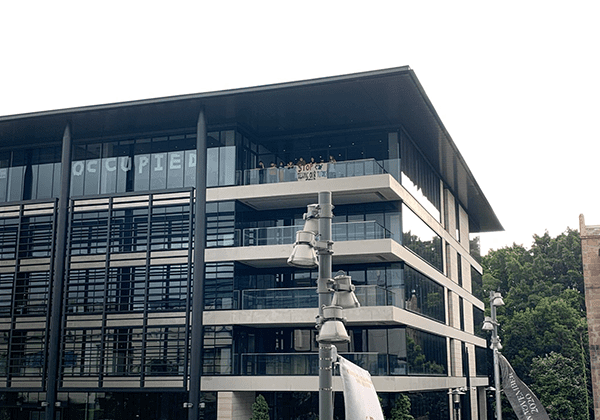Most weeks, as barely more than a dozen scrawny students gather outside Fisher Library to hear speeches against the latest malady to hit higher education, down the extreme opposite end of Eastern Avenue, the F23 Administration Building goes into lockdown, completely halting access to that foreboding monument to management.
The University’s reflex to lock itself away in its Camperdown keep at the slightest sign of student dissent is concerning in itself, casting aggrieved students as security threats rather than equally invested members of the USyd community. But such an attitude is also evident in other aspects of the University, and the broader trend of staff separation from students warrants examination.
In the very first scene of the 1997 documentary Uni, Charles Firth strides into a building in hope of obtaining a very questionable extension. Finding his lecturer out of office, he casually consults another staff member before finding assistance at a well-staffed administration desk. Such a scene — of interaction with living, breathing staff members outside of class — is one foreign to many undergraduate students today. After faculty administration desks were closed in a 2016 cost-cutting measure, all administrative inquiries have been centralised and channeled through the black hole of the 1800 SYD UNI phone line, where an inevitable months-long chain of email referrals awaits.
While admin staff are sacked and centralised, academics have become segregated from students in the name of “security.” The New Law Building, completed in 2009, was Camperdown’s first “secure building,” with staff separated from students by not merely doors and floors, but also an impenetrable swipe-access barrier. The concept has since proliferated throughout the campus, with academics in the new FASS building, for example, sequestered from students by a glass barricade. When not locked down for fear of being overrun by students, F23 staff are guarded by a campus security detail and an array of electronic locking mechanisms. This cloistering of staff is not a belated return to the monastic academic tradition, but rather signifies the sacrifice of an essential aspect of the university — community — for a corporate aesthetic.
‘University’ has its origins in the Latin universitas magistrorum et scholarium (roughly, a community of masters and scholars), implying, according to William Schonfeld, “a company of persons, a community, a body…organised for the sake of its protection from hostile outsiders.” While this detachment from society is clearly unsustainable in the modern age, there is a necessary insularity in the scholarly business of the university — concerned with knowledge production rather than economic production — which should separate it from other organisations. The co-location of “masters and scholars” — of old and young — in the campus is a necessary aspect of the university, encouraging learning and debate in both casual and formal settings, and allowing the knowledge transfer which sustains academia. By sequestering academic staff behind locked doors, something of this shared community is lost, and “masters” and “scholars” come to exist as two distinctly separate communities which rarely interact with each other outside of formal settings. Simply having the opportunity to drop by and speak to academics or faculty in person encourages a sense of belonging and investment in the university. By contrast, the present system of call centres, online forms and email-only communication merely furthers the atomisation felt by the contemporary student. How can one feel attached to an institution that treats its students in the same way a corporation treats its customers — in the cheapest and most efficient way possible?.
By the same token, the anonymity and media-managed pronouncements of University management contribute to this ever-widening distinction between “masters” and “scholars.” While universities will always need management to make difficult and unpopular decisions, the distinction between principles of corporate management and university governance are that decision-makers, at USyd at least, are generally high-achieving academics who have forged careers through frank and open discussion, clear communication, and consideration of, and engagement with, pertinent debates.
Against this background, the existence of a PR-driven ‘University spokesperson’ seems anomalous. Among the core principles of PR are obfuscation, damage minimisation and image protection. These are principles which should be anathema to an academic institution which ostensibly prioritises academic freedom and honest debate. Delegating communication with student media to a reputation-focused anonymous ‘spokesperson’ evinces a willingness to avoid honest engagement with the university community, especially students. The empty corporate prose of Pip Pattison’s Honi op-ed shows that, even when given the opportunity to justify their actions and engage with debate, management are unwilling to do so. The appointment of Mark Scott as Vice-Chancellor — a non-academic corporate operator — is evidence of a further acceleration away from academic community and towards corporate goals.
Certainly, the University deserves some modicum of sympathy in dealing with a hostile government and strained financial circumstances. However, such problems should not be dealt with by abandoning the honest engagement in debate which is inherent in academia for a corporate communications strategy which prioritises image over honesty, and anonymity over responsibility, treating students with an attitude bordering on disdain.
A university does not have shareholders or customers to whom it must sell itself. Its whole being is centred on academic production — opinions on the purposes of which may differ — and such production rests on interaction between “masters” and “scholars.” Reducing interaction between these groups, and segregating students, staff and management through architectural and communications choices, does a disservice to the university, atomising the sense of community upon which it relies.





